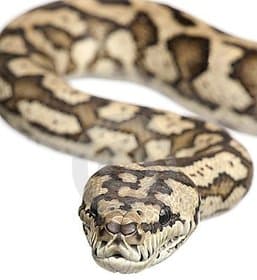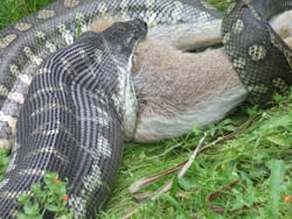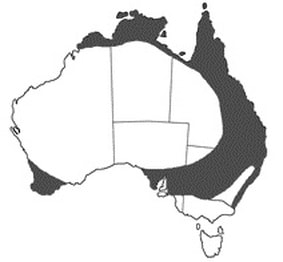Carpet PythonMorelia spilota |

Custom Search
|
These snakes are found in mainland Australia, throughout northern, southern and eastern regions of Australia. But also in the arid islands of the Nuyts Archipelago, where it shares the habitat with a subspecies of the highly venomous tiger snake.
The carpet python isn't usually found in the most arid regions like Central and Western Australia and Tasmania. Even so, this is the most widespread of the Australian pythons. The species is also found in southern Indonesia , Papua New Guinea and on Yule Island. The several subspecies are found in a variety of habitats like temperate grasslands, rainforests, open forests, woodlands, coastal heaths, rural lands, park lands and suburban gardens. The diamond python (M. s. spilota) can even be found in regions where snowfall occurs in the winter. Carpet python are considered semi-arboreal snakes easily climbing trees and shrubs, but also move around in more open areas like forest floor, rock faces and can even be seen crossing roads. They are mostly active at night, however they are also commonly seen coiled up basking in the sun during the day.

The carpet python several subspecies coloration and pattern is highly variable. The species color ranges from olive, dark or light green, brown and even black.
The pattern consists of white or cream and gold markings, in a roughly diamond shape, splotches, light and dark bands, stripes or colored rings. The species is also known by other common names like carpet snake, Western Australian Carpet Python or inland rivers carpet python. They get their common name from their beautiful pattern which reminds us of an oriental carpet pattern. A Carpet python average adult size is around roughly 2 metres (6.6 ft) but it can reach 13 ft (4 m) in length and weigh up to 33 lb (15 kg). But still not as large as the olive python (Liasis olivaceus) or the scrub python (Morelia amethistina). The largest subspecies it the Coastal carpet python and regularly reaches 10 ft (3 m), and the smallest is the Darwin carpet python that averages only 4 to 6 ft (120 to 180 cm) in length. Females are usually larger than males, and can be up to 4 times heavier. Their head is triangular with a distinctive row of thermoreceptive labial pits. The carpet python is popular among snake enthusiasts. Although some subspecies are more calm like the diamond python others are more irascible such as coastal carpet python or the darwin carpet python. These large bodied snakes can probably live up to 20 years or even more in the wild, and even longer captivity. Taxonomy / Subspecies The carpet python was first described by Lacépède in 1804, who placed in the genus Coluber as Coluber spilotus. Since the carpet python color and pattern is extremely variable scientists have described many subspecies over time. There is some conflicting information, with the subspecies numbers ranging from 6 up to 8 as listed by the IUCN. Their roaming habits and discrete nature led to a limited number of recorded specimens, making it even more difficult to support descriptions of all those taxon's morphology. These are the most widely accepted common names combined with their geographic distribution: Southern carpet python (M. s. imbricata) - Found from Southwest Australia to the South in the Eyre Peninsula. Jungle carpet python (M. s. cheynei) - Found in Australia in the northeastern Queensland region. Inland carpet python (M. s. metcalfei) - Found in the Queensland Murray-Darling Basin, Victoria, New South Wales, and South Australia. Coastal carpet python (M. s. mcdowelli) - Found in northeastern New South Wales and eastern Queensland in Australia. Diamond python (M. s. spilota) - Found only in the extreme east of Victoria and eastern New South Wales in Australia. Darwin carpet python (M. s. variegata) - Australia in northwestern Western Australia and in the northern portion of the Northern Territory. Papuan carpet python (M. s. harrisoni)- Known also as Irian Jaya is found in Western New Guinea and Papua New Guinea.  Carpet python eating a Red-Necked wallaby Carpet python eating a Red-Necked wallaby
Diet / Feeding
The carpet python feeds mostly on frogs, lizards, birds and mammals like rodents, possums and wallabies, since these are non-venomous snakes they kill their prey by constricting it until it dies and then swallow it whole. Smaller and younger snakes feed preferably on lizards. Like other animals they will sometimes eat cane toads with fatal consequences. Carpet pythons like most snake species are ambush hunters waiting for their prey to pass by. Since it feeds mostly after dark it uses heat-sensitive pits on their bottom jaw they sense and track the prey's body heat. Since carpet pythons are often found near human habitation, the species performs a useful service controlling the population of rats and other vermin. There are also reports of them killing and eating small dogs. Reproduction Carpet python males have been observed fighting in spring. The species is oviparous, meaning these snakes lay eggs. Females lay a clutch of 10 to 45 eggs in early summer, concealing them in sheltered sites like hollow stumps or depressions in the ground, between hay bales or building materials. Carpet python females coil around the eggs to defend but also to incubate them by shivering to generate heat. Female only leave the nest in the morning to bask and return to the nest after they have heated from the sun. Hatchlings measure around 12 to 15 inches (30 to 40 cm) at birth. Conservation / Threats The carpet python is considered as a Least Concern species due to their large distribution and adaptability to a wide range of habitats, that include even urban areas. The species is also listed on Appendix II of CITES. Although the carpet python isn't threatened as a species, some of it's several subspecies are under pressure. Like the Southern carpet python (M. s. imbricata) considered as near threatened in Western Australia. Or the diamond python (M. s. spilota) which is threatened with extinction in Victoria. Although they are found in the exotic pet trade, collection from the wild is considered minimal to cause any substantial decline. Habitat loss on the other hand has caused some localized population declines, due mainly to agricultural expansion and overgrazing by livestock.
|
Did You Know?
The death adder isn't a true adder, it belongs to another entirely different family the elapidae. Scientific classification |
© 2014 Snake Facts About Us | Privacy Policy | Contact




